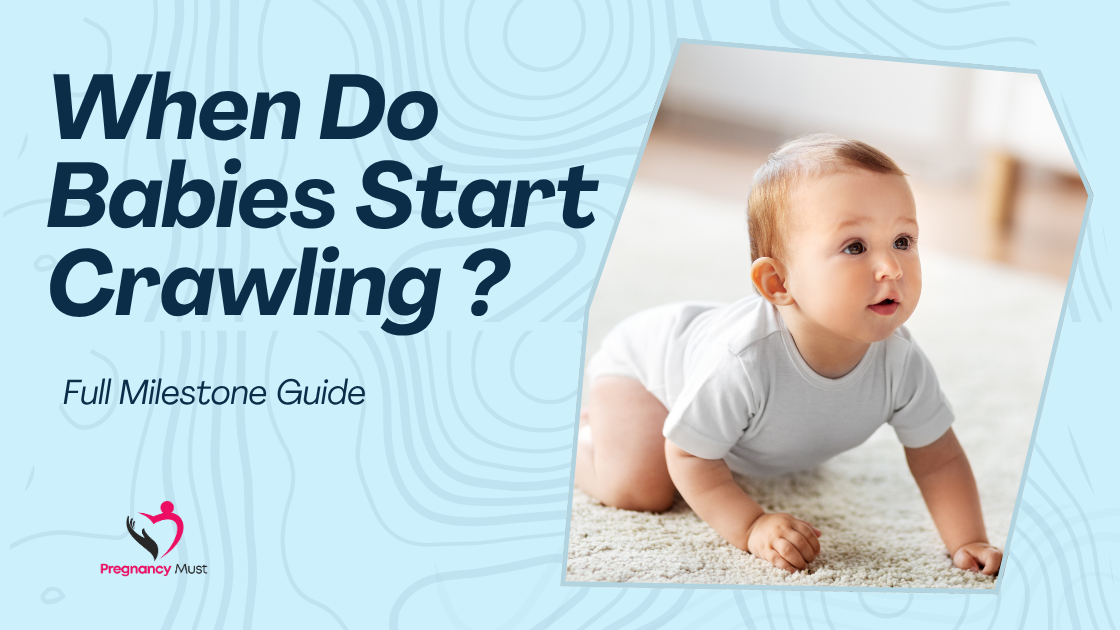When do babies start crawling? This is also one of the most thrilling questions that new parents are fond of asking, just as they anticipate every development milestone of their baby. Being aware of the symptoms, methods, and assistance principles can help this process come out of hell and into a happier place. Crawling is not purely a physical milestone, but it is also one of the most important markers of development milestones in terms of the baby and its relationship to its body and the world around it. With the idea of such a step at hand, parents get time to prepare practically and emotionally.
Many parents also wonder when do babies start crawling if they were born prematurely, or tend to be less active. The answer can vary based on many factors, which we’ll explore below.
Table of Contents
- Understanding Baby Crawling Development
- Additional Tips for Parents During the Crawling Phase
- How to Encourage Crawling
- When Do Babies Start Crawling and What Influences It?
- Common Myths About Crawling
- How to Baby-Proof Your Home
- Nutrition and Crawling Development
- Cultural Differences in Crawling
- Frequently Asked Questions: When Do Babies Start Crawling
- Final Thoughts
Understanding Baby Crawling Development
Crawling marks a major transition in a baby’s mobility and independence. It lays the foundation for walking, balance, and muscle coordination. When do babies start crawling? Most babies begin to crawl between 6 and 10 months of age, but every child develops at their own pace. During this stage, babies also begin to develop more confidence in their physical abilities and interactions with their environment. This period may also show a boost in your baby’s ability to recognize faces, reach for favorite toys, and respond to their name.
Why Crawling is a Key Milestone
Crawling is more than just getting around the house. It promotes:
- Muscle Strength: It builds arm, leg, neck, and back muscles, preparing the body for walking. These movements help babies gain full control of their upper and lower body.
- Brain Development: Coordinates left and right brain hemispheres, improving cognitive skills. The bilateral movement used in crawling creates strong neural connections.
- Spatial Awareness: Helps understand distance and direction, which is essential for physical orientation. It lays the groundwork for more complex tasks like running or playing catch.
- Hand-Eye Coordination: Essential for future skills like writing and feeding and for grasping objects accurately. Crawling also enhances depth perception, as babies judge how far objects are.
Additional Tips for Parents During the Crawling Phase
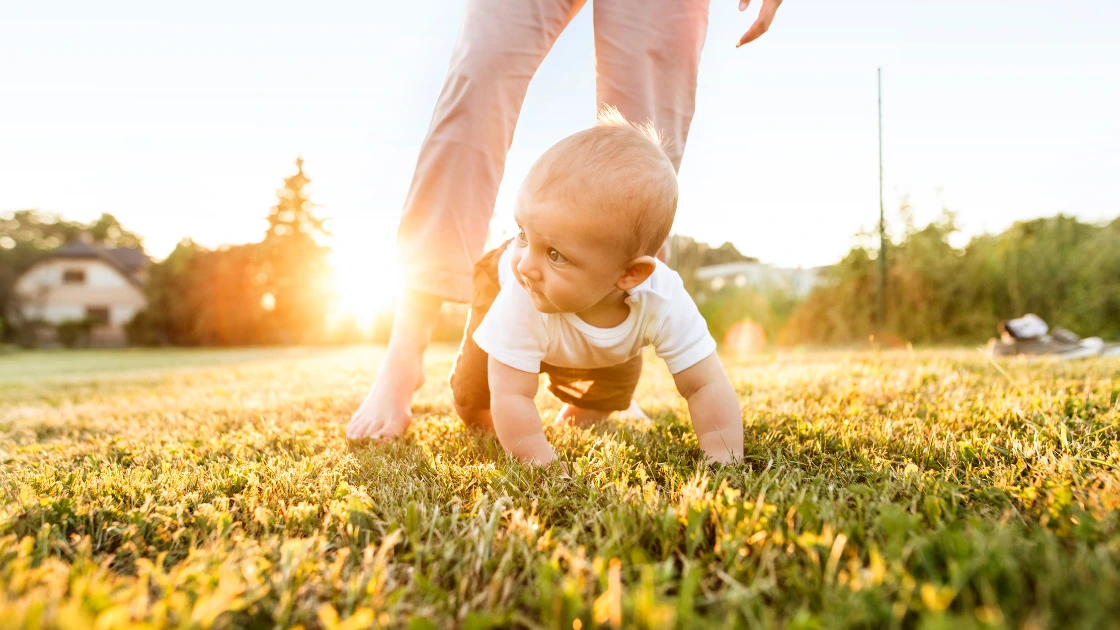
In order to monitor the progress of crawling being made, one should be updated and flexible. One should not be busy comparing the developmental milestones of his or her child with other children. The path of each baby is not the same. Encourage them on the little achievements and take this as a way of interesting learning.
When your baby crawls, you should talk to him or her to build language skills. Promote interplay by describing what they are doing, and you always use positive affirmation, such as, You are so doing well! These small limits take far between building a child that is well-able and confident.
Finally, you cannot ignore yourself. The crawling stage may even be tiresome to the parents. Ensure that you are resting, get help when necessary, and make the most out of this very short but significant period in the life of your baby.
How to Encourage Crawling
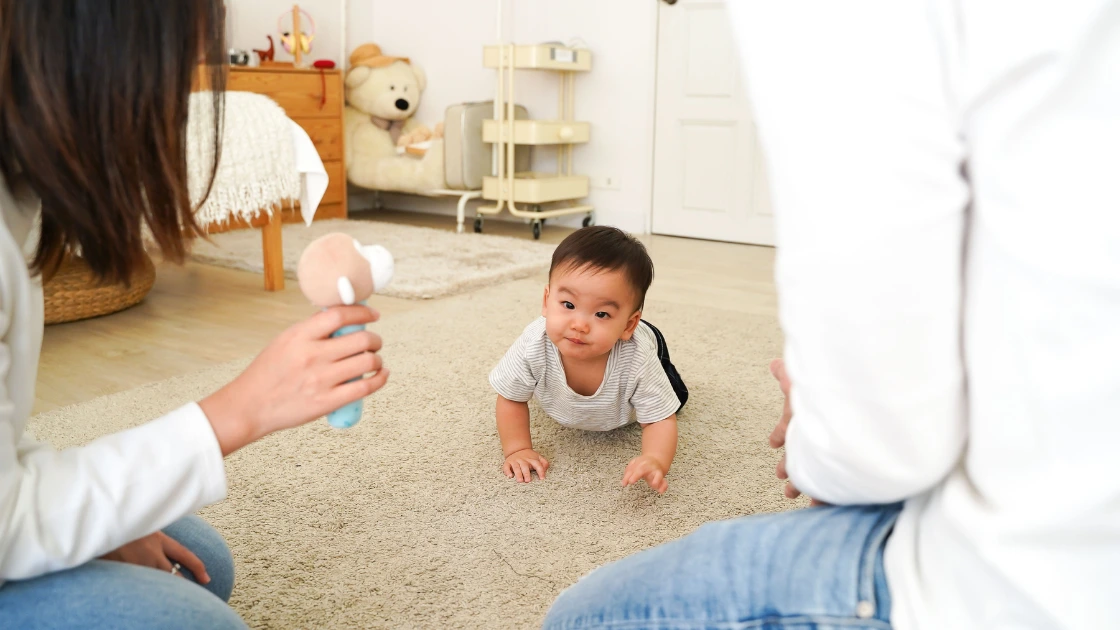
Parents play a crucial role in motivating their babies to crawl. Here’s how to set up the right environment and routine to support them. Encouragement, patience, and creativity make a significant difference during this phase. Understanding when babies start crawling can help you time these activities effectively.
Make Tummy Time Fun
Place toys within reach, lie down next to your baby, or use mirrors to keep them entertained. Keep sessions consistent and cheerful. Incorporate songs or baby-safe sensory toys to keep their interest longer.
Create a Safe Space
Clear a clean, padded space on the floor where the baby can explore safely. Remove sharp edges and provide ample room. Make sure the space is free from pet hazards and has good lighting.
Limit Time in Containers
Avoid overusing baby swings, walkers, or carriers that restrict movement. Freedom is essential for muscle development. Allow them floor time during play to stretch and explore more naturally.
Use Toys for Motivation
Place favorite toys just out of reach to encourage movement. Interactive toys that make noise can be extra motivating. Try rotating toys regularly to maintain novelty and interest.
Get on the Floor with Them
Babies often mimic their caregivers. Crawling with your baby can be great motivation and adds bonding time. Use encouraging language and facial expressions to further inspire action.
Build Baby Obstacle Courses
Use soft pillows, cushions, and tunnels to create fun challenges. Make sure everything is baby-safe and age-appropriate. Changing the setup often keeps it exciting and builds new skills.
Encourage Crawling Through Games
Play peekaboo from across the room or use a flashlight to encourage the baby to follow the light. Games make movement feel like play, not work. Hide and seek with toys also fosters crawling skills.
These techniques can help regardless of when babies usually start crawling, giving your baby the best shot at hitting this milestone confidently.
When Do Babies Start Crawling and What Influences It?
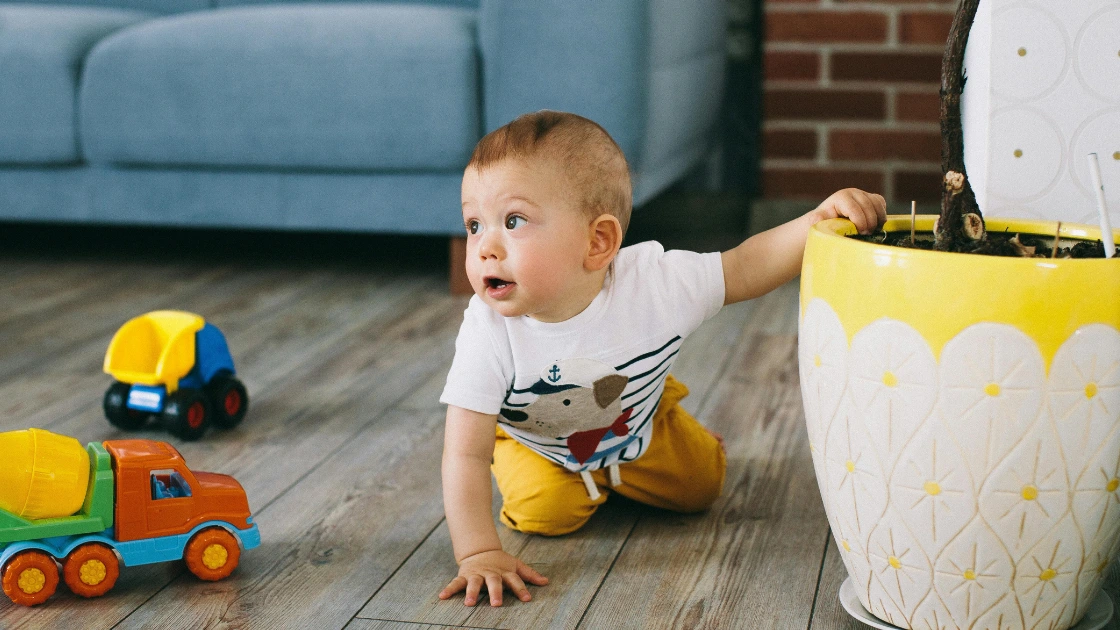
The answer to when babies start crawling can vary based on several factors. All these factors have an effect on when crawling starts and how it goes. It is not necessary to overlook such influences because parents can use them to comprehend and guide their baby through the distinct developmental process.
Still wondering when babies typically start crawling in different environments? Keep in mind that everything from family genetics to stimulation plays a role.
Physical Development
Babies with strong core, arm, and leg muscles may start crawling earlier. Frequent movement and play encourage this. Activities that build muscle tone, like supported sitting and gentle stretching, can help.
Time Spent on Tummy
Tummy time strengthens the muscles needed for crawling. Babies who get daily tummy time may crawl sooner and more effectively. Start with short sessions and gradually increase the duration as your baby adjusts.
Personality and Temperament
Some babies are eager explorers, while others are more content observing the world. Motivation can influence mobility. Outgoing babies may crawl earlier simply due to curiosity and a desire for new experiences.
Premature Birth
The prematurely born children may be slow in crawling as compared to full-term nurslings. Their bodies could require a longer time to catch up. Take note of milestones according to adjusted age rather than according to the same birth date.
Genetics and Family History
If other family members crawled late or skipped crawling altogether, your baby might, too. Genetic traits often play a role. Some inherited patterns may delay physical milestones without causing any developmental issues.
Environment
More movement is stimulated in an engaging setting. Crawling readiness can be enhanced by safe floors, inspirational toys, and interactive play. Crawling usually comes earlier in homes with busy family schedules. Babies mimic what they see, so being on the floor with them helps, too.
Some parents may observe that when do babies start crawling in a busy, interactive household might be earlier than in quieter, more contained spaces.
Common Myths About Crawling
Let’s debunk a few myths around baby crawling. Accurate information ensures you support your baby appropriately and avoid unnecessary worry or pressure during this stage.
Myth: All Babies Crawl
Not true. Some babies skip crawling altogether and move directly to walking. It’s perfectly normal. Many pediatricians consider alternative forms of mobility completely healthy and acceptable.
Myth: Crawling Early Means Walking Early
Not necessarily. Each motor skill develops on its own timeline. Rushing one doesn’t guarantee advancement in another. In fact, some babies crawl early and walk much later.
Myth: Crawling Should Be Forced
Babies develop best when given the freedom to explore naturally. Encouragement is key, not pressure. Forced crawling can cause frustration and may delay independent learning.
Myth: Late Crawlers Are Behind
Crawling later than peers doesn’t mean your baby is delayed. Development is highly individual and influenced by many factors. Late crawling does not impact future motor success.
How to Baby-Proof Your Home
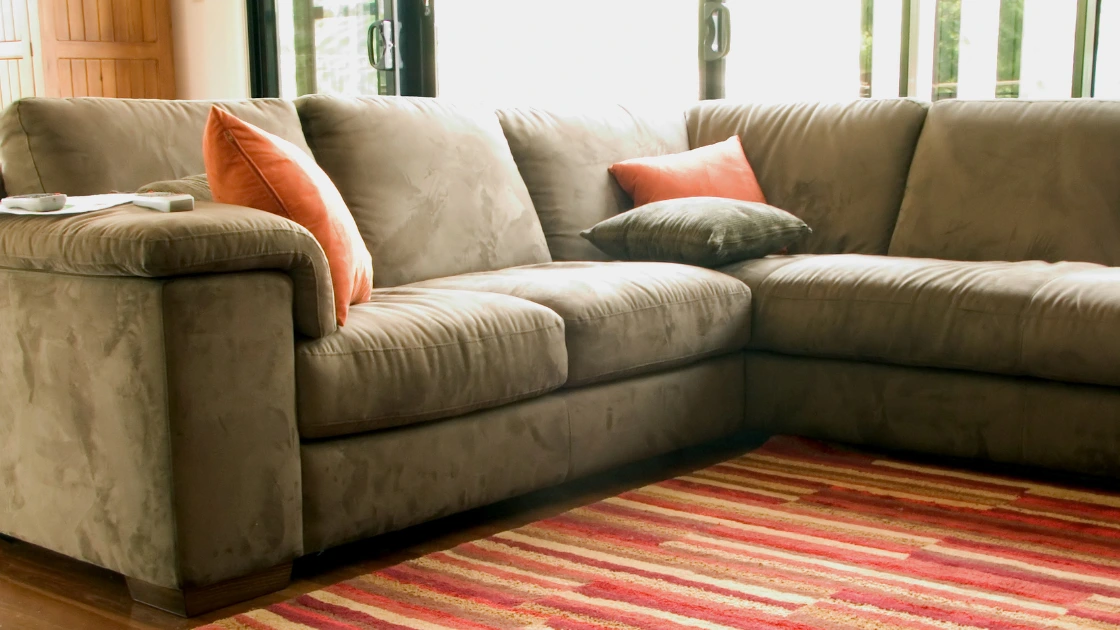
With crawling comes the need for safety. Here’s how to prepare your home and create a secure exploration zone that supports your baby’s growing curiosity and movement.
Anchor Furniture
Secure heavy furniture to the wall to prevent tipping. This includes bookshelves, TVs, and drawers. Babies love to pull themselves up, so anchoring is a must.
Use Outlet Covers
Cover all electrical outlets within your baby’s reach. Electrical safety is crucial as curiosity increases. Babies are drawn to small holes and shiny things.
Install Baby Gates
Place gates at the top and bottom of the stairs. Consider barriers for certain rooms as well. This helps limit access and keeps them within view.
Remove Choking Hazards
Keep small objects out of reach. Regularly scan the floor for fallen items. Babies tend to explore the world by putting things in their mouths.
Cushion Corners
Use soft guards on sharp furniture edges. Protect your baby from bumps and bruises. Tables, beds, and cabinets should all be cushioned.
Lock Cabinets and Drawers
Install child safety locks to prevent access to harmful items. Secure cleaning supplies and medications. Even everyday kitchen items can pose a risk.
Secure Cords and Blinds
Tie up window cords and remove any loose strings that could pose a strangulation risk. Cordless blinds are even better. Always supervise in rooms with potential hazards.
Knowing the truth behind these myths can help parents better understand when most babies start crawling and why variation is entirely normal.
The Emotional Side of Crawling
Watching your baby crawl is emotional for many parents. It marks the beginning of independence. Embrace the excitement and the challenges together as your baby takes this big step forward.
- Take lots of photos and videos. Documenting progress creates lasting memories. Share them with loved ones to celebrate these achievements.
- Celebrate small progress. Each inch forward is a big win. Don’t compare your child to others—growth is unique.
- Be patient and encouraging. Positive reinforcement boosts confidence. Your energy and reactions matter more than you think.
Bonding Through Movement
Crawling time is also bonding time. Encourage siblings or other family members to join in floor play. Family interaction boosts emotional well-being and creates playful shared experiences.
Journaling Progress
Keep a milestone journal or scrapbook to track and cherish developmental steps. It also helps during pediatric visits. Looking back can be rewarding for both you and your child.
Nutrition and Crawling Development

Diet plays a big role in physical development. A baby who is well-nourished is more likely to meet their motor milestones. Food is fuel for growth.
Essential Nutrients:
- Iron: Supports brain development and energy levels
- Vitamin D: Essential for bone and muscle growth and development
- Protein: Builds muscle strength and overall health
- Omega-3s: Supports nervous system development and visual acuity
Breastfeeding and Crawling
Breastmilk provides vital nutrients and immunity that support healthy development. It also nurtures the parent-child bond.
Cultural Differences in Crawling
Across different cultures, baby milestones vary. The expectations and approaches to crawling may differ significantly.
- Babies are carried more frequently and may crawl later. It’s a natural difference in caregiving styles.
- Floor time is encouraged from a younger age, leading to earlier crawling. This often happens in cultures emphasizing independent mobility.
- The use of crawling to transition to toddlerhood is performed by some and is celebrated using traditional practices. These rituals give some cultural meaning to the development.
Frequently Asked Questions: When Do Babies Start Crawling
Q1: When do babies start crawling typically?
Most babies start crawling between 6 to 10 months. It varies depending on development and environment.
Q2: Is it normal if my baby doesn’t crawl?
Yes, some babies skip crawling and move straight to walking or scooting. It’s not necessarily a cause for concern.
Q3: How can I encourage my baby to crawl?
Tummy time, toys, and your engagement on the floor all help. Consistency is key to success.
Q4: Should I be worried if my baby isn’t crawling at 10 months?
Not necessarily. Monitor other signs of development and consult your pediatrician if concerned. Every baby is different.
Q5: What kind of crawling is best?
The classic cross-crawl is often most beneficial for brain coordination, but any form of crawling is healthy. Let your baby explore.
Q6: Can babies crawl too much?
Not really. More crawling means more muscle and brain development. Just ensure safe conditions.
Q7: What surfaces are best for crawling?
Soft, clean floors with baby mats or rugs are ideal. Avoid slippery or overly hard surfaces.
Final Thoughts
So, when do babies start crawling? Usually, it runs between 6-10 months, but your baby can follow a different route. The trick is to promote, monitor, and praise their growth without anxiety. Stay engaged, keep their space safe, and know that every baby develops at their own pace. Crawling is a beautiful milestone that deserves support, patience, and lots of love.
Whether you’re curious about when do babies usually start crawling, when do babies normally start crawling, or even when do babies start crawling, the answer lies in understanding that every baby grows on their own timeline—with your love and encouragement lighting the way.
Explore More on Pregnancy Must –
